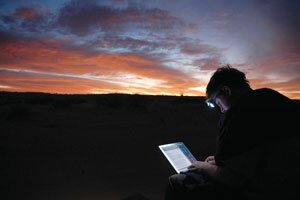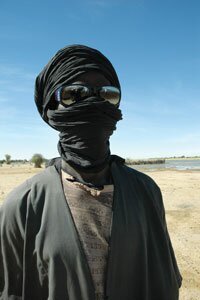NEWS- Thirst for adventure: Across the Sahara by foot in 90 days
It's 4am, and we're somewhere along the Mali/Mauritania border in the middle of the Sahara desert. I'm stretched out in my sleeping bag and peeking through the tent flaps at the bright canopy of stars growing dimmer in the first rays of the red morning sun. A stray camel leaves a pile of steaming dung on its way by. Another day has begun.
A hundred yards away, I hear the voices of three men dressing in the dark, their headlamps flickering like frenetic lightning bugs. Shirts are pulled on, socks stretched over blistered feet, shoelaces tightened. Someone laughs at a dirty joke.
These guys are truly crazy. They'll soon be back out on this sand road (if it can be called a road) to put another 50 miles behind them on foot.
"It's astonishing," says weary-eyed Donovan Webster. The well-known Charlottesville-based National Geographic writer is discussing the last couple of hundred miles through Mauritania. "Every mile or so," says Webster, "you come upon the stinking corpse of a dead donkey, goat, sheep, cow, dog, zebu, camel, or horse."
As most of these animals are social, we often find two of them have been killed simultaneously by a vehicle, leaving them tangled together at the roadside. In rare places, the smashed cars line the roads' shoulders as well, the aftermath of a car-on-camel collision.
Anyway, beyond the carnage, the highway has offered us other glimpses into Mauritania. We've been stopping at wells and in roadside villages, talking with the locals, all of whom want better resources– more and better-quality water, and more social services.
The expedition is called Running the Sahara, and we're here tailing a small documentary film crew recording what might be one of the greatest human feats ever: three men attempting to cross the Sahara desert by foot in 90 days. That's 4,000 miles, 50 miles a day– a double marathon every 24 hours.
The three friends, Charlie Engle (America), Kevin Lin (Taiwan), and Ray Zahab (Canada), are the world's top ultra-marathoners with zero visible body fat among them. Their perseverance on this quest that started in Senegal and ends in Cairo is topped only by their enthusiasm to be the first men to accomplish it.
Traveling with me is Albemarle resident, ex-Dave Matthews Band keyboardist, and One Campaign outreach coordinator Peter Griesar. He's here to record the sights and sounds of the trip for the One.org website in the form of podcasts and video webisodes. I can hear him snoring softly behind me, cocooned in his one-man tent. I should wake him up so he can witness this beautiful sunrise, but I've already over-worked him the past week in Timbuktu.
American runner Engle originally came up with the idea for the Sahara run and took it to Academy award-winning helmsman James Moll, who cut his teeth years ago working with Steven Spielberg. Moll in turn took the project to his friend Matt Damon, the actor who will narrate. After shooting wraps in January, the film is set to premiere in September at the Toronto Film Festival.
Our guides through this barren landscape have been the blue-robed Tuaregs. The nomadic Muslim tribesmen in the distinctive indigo-stained "bubu" dresses have crisscrossed this desert for the past few centuries by camel and foot as overseers of a salt, slave, and gold trade that reached its peak in the 15th and 16th centuries.
The capable and friendly Tuaregs do most of the hard work: tending the fires, breaking camp, slaughtering the goats for dinner, and brewing an afternoon hot sweet tea that kicks you in the stomach twice before loosening your bowels.
"They say the first sip of Tuareg tea is strong like death," says Griesar with a wry smile. "The second is sweet like life, and third sip is sugar like love."
The Tuareg drive fast and hard, like Pari-to-Dakar competition 4x4 drivers through the thick burning sand. They don't need a GPS to tell their position, and thanks to arranged marriages that have deposited cousins and relatives of our crew in just about every village we pass, their clans guarantee us safe passage across the desert.
The rest of the documentary film crew is a small, hardy lot of American and German men who smoke hand-rolled cigarettes, drink tea in the shade of thorn trees after lunch, and take an occasional nip of whiskey at the end of the day. They're a good group, either stupid or foolhardy enough to sign up for a three-month slow ride across the desert by 4-wheel drive and Mercedes' Unimog. They communicate with their loved ones and keep up with NFL scores through satellite Internet.
When Griesar and I entered the runners' base camp last night at the Mali border, our headlamps flooded Webster's familiar face. He recently won the Lowell Thomas Award for best foreign travel writing, but the only skills we care about right now are those he can offer as expedition leader and a veteran of this trek.
Also along on the adventure are a doctor and a Tuareg chef (who makes incredible onion and corn pizzas), boom operators, videographers, and sometimes a National Geographic TV crew who are filming part of the expedition for a future broadcast.
Despite a few raging foot blisters and stomach ailments, the expedition so far has been right on track, covering anywhere from 40 to 50 miles a day. Their incredible stamina and determination is breath-taking. I'm sweating just looking for the DEET and suntan lotion.

Fifty miles a day– in the desert

A tuareg man
PHOTOS BY J. TAYLOE EMERY
#